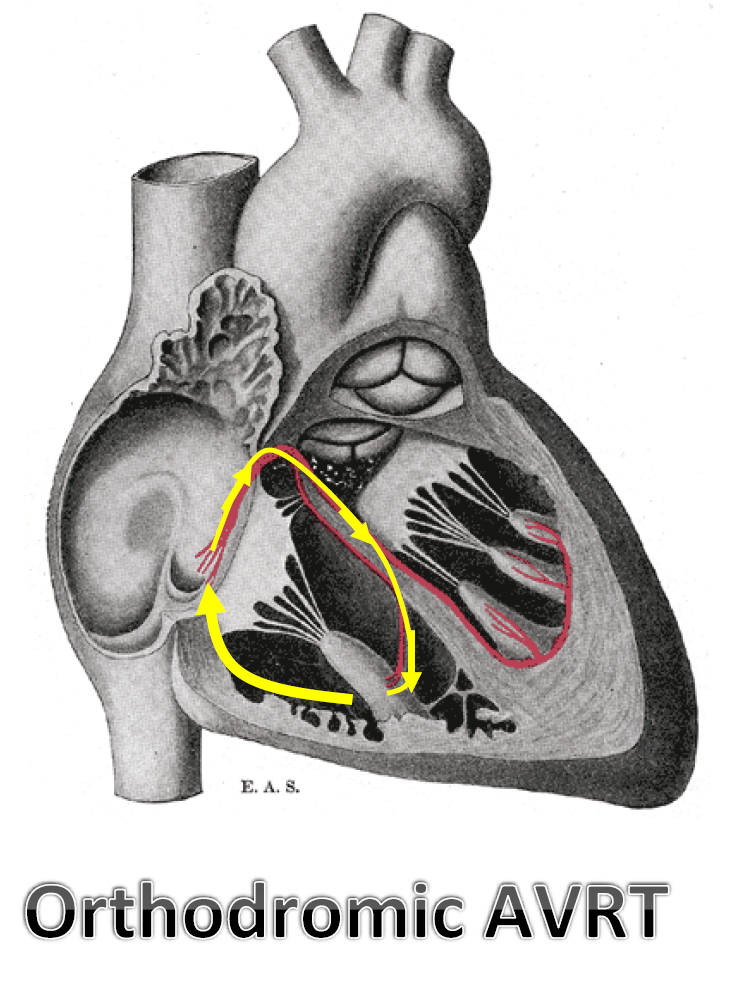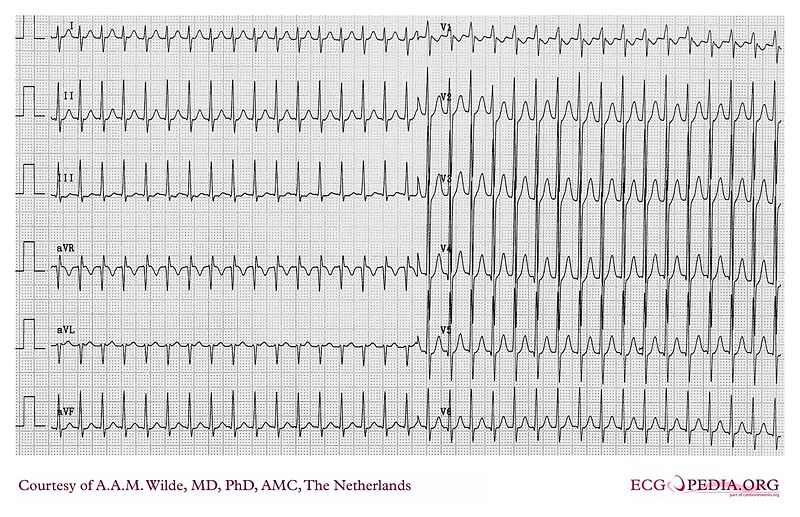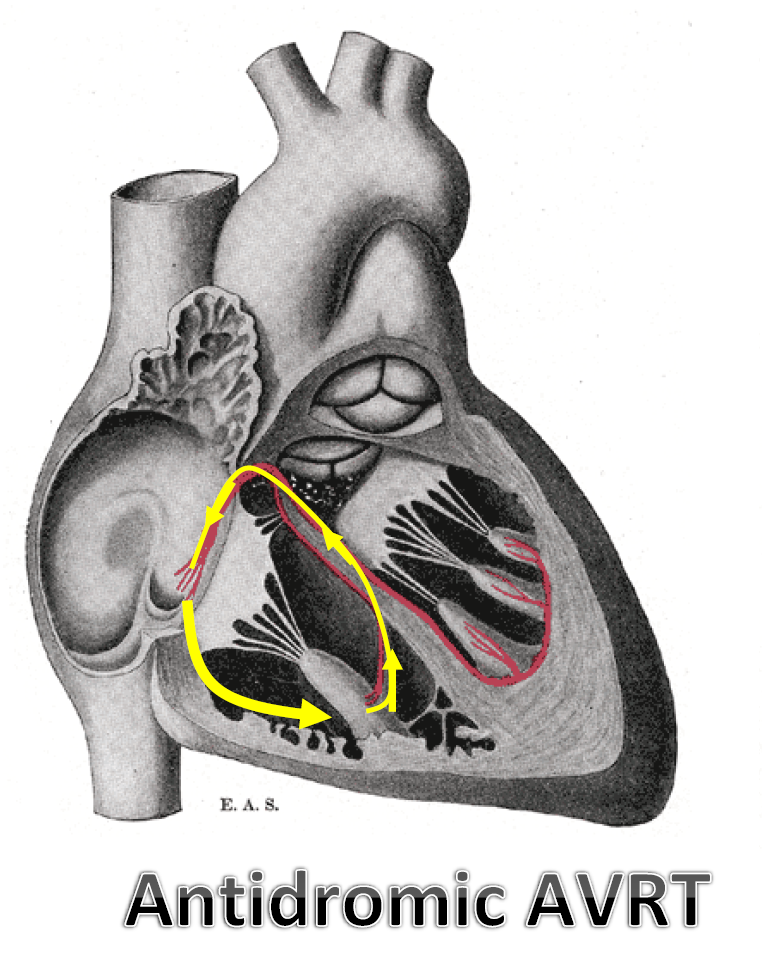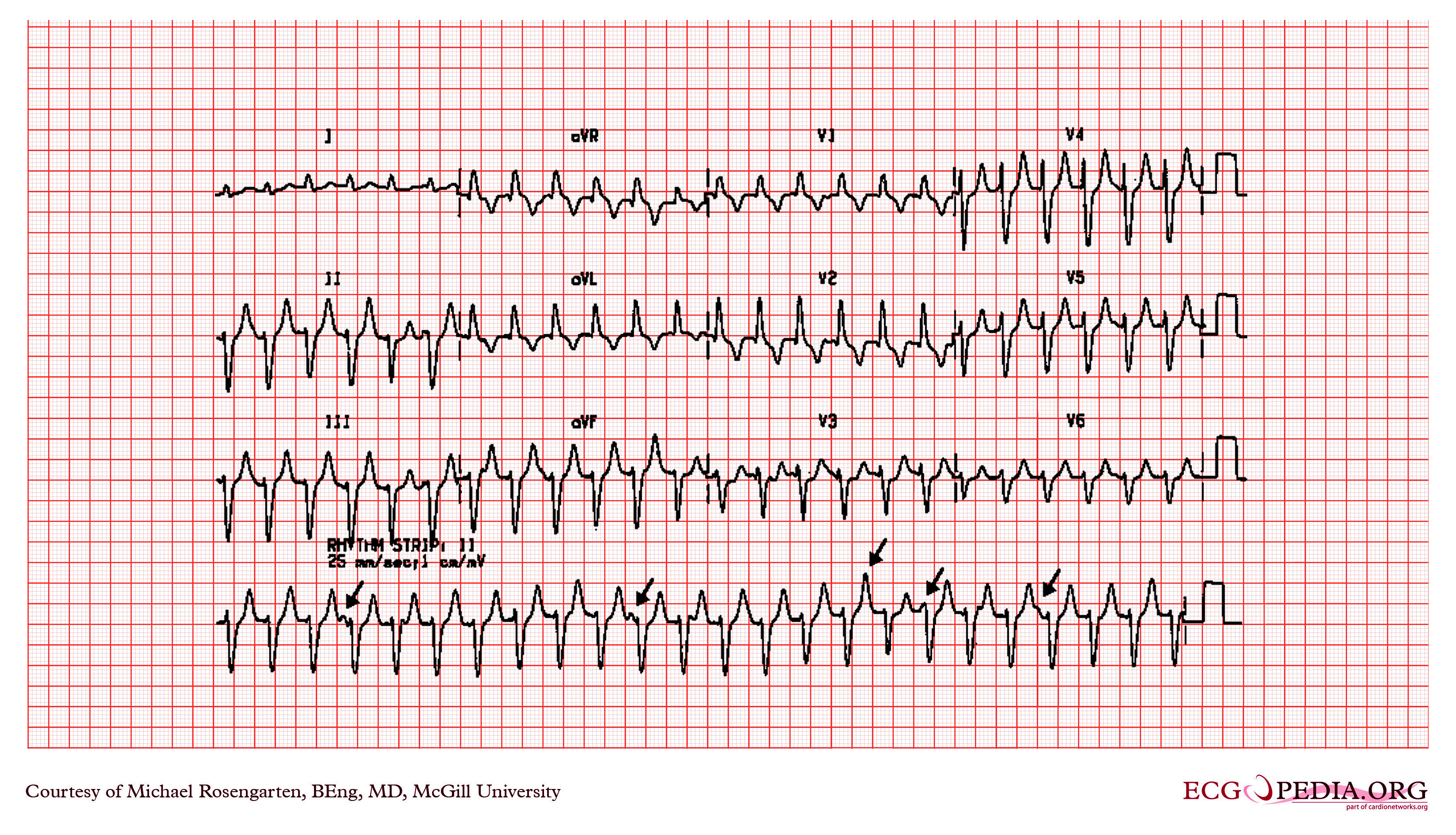Wolff-Parkinson-White syndrome resident survival guide: Difference between revisions
No edit summary |
|||
| Line 16: | Line 16: | ||
! style="font-size: 80%; padding: 0 5px; background: #DCDCDC" align=left | [[Wolff-Parkinson-White syndrome resident survival guide#Management|Management]] | ! style="font-size: 80%; padding: 0 5px; background: #DCDCDC" align=left | [[Wolff-Parkinson-White syndrome resident survival guide#Management|Management]] | ||
:[[Wolff-Parkinson-White syndrome resident survival guide#Long-term Management|Long-term Management]] | :[[Wolff-Parkinson-White syndrome resident survival guide#Long-term Management|Long-term Management]] | ||
:[[Wolff-Parkinson-White syndrome resident survival guide#Wolff-Parkinson-White syndrome with | :[[Wolff-Parkinson-White syndrome resident survival guide#Wolff-Parkinson-White syndrome with atrial fibrillation|WPW with AF]] | ||
|- | |- | ||
! style="font-size: 80%; padding: 0 5px; background: #DCDCDC" align=left | [[Wolff-Parkinson-White syndrome resident survival guide#Do's|Do's]] | ! style="font-size: 80%; padding: 0 5px; background: #DCDCDC" align=left | [[Wolff-Parkinson-White syndrome resident survival guide#Do's|Do's]] | ||
| Line 149: | Line 149: | ||
{{familytree | G01 | | G02 | | | | G01= <div style="float: left; text-align: left; width: 24em; padding:1em;"> '''Treatment'''<br> | {{familytree | G01 | | G02 | | | | G01= <div style="float: left; text-align: left; width: 24em; padding:1em;"> '''Treatment'''<br> | ||
❑ Use [[vagal maneuvers]] ([[ACC AHA guidelines classification scheme|class I, level of evidence B]])<br> | ❑ Use [[vagal maneuvers]] ([[ACC AHA guidelines classification scheme|class I, level of evidence B]])<br> | ||
:❑ [[Carotid sinus massage]] <br> | :❑ [[Carotid sinus massage]] <br> | ||
:❑ [[Valsalva maneuver]] <br> | :❑ [[Valsalva maneuver]] <br> | ||
<br>''If not effective initiate IV AV nodal blocking agent''<br><br> | <br>''If not effective initiate IV AV nodal blocking agent''<br><br> | ||
❑ Administer [[adenosine]] 6 mg | ❑ Administer [[adenosine]] 6 mg given as a rapid intravenous bolus (administered over a 1-2 second period) ([[ACC AHA guidelines classification scheme|class I, level of evidence A]])<br> | ||
: ❑ If initial dose not effective, administer a second dose of 12 mg <br> | : ❑ If initial dose not effective, administer a second dose of 12 mg. This 12 mg dose may be repeated a second time if required.<br> | ||
:<span style="font-size:85%;color:red">Contraindications: second- or third-degree A-V block, sinus node disease</span><br> | :<span style="font-size:85%;color:red">Contraindications: second- or third-degree A-V block, sinus node disease</span><br> | ||
<br>''If not effective''<br><br> | <br>''If not effective''<br><br> | ||
❑ Administer [[verapamil]], | ❑ Administer [[verapamil]], boluses of 5 mg to acumulate 15 mg. ([[ACC AHA guidelines classification scheme|class I, level of evidence A]])<br> | ||
:❑ | :❑ Use lower doses to reach the same level in patients with reanal impairment<br> | ||
:<span style="font-size:85%;color:red">Contraindications: hypotension (systolic pressure less than 90 mm Hg) or cardiogenic shock, patients with known hypersensitivity to verapamil hydrochloride</span><br> | :<span style="font-size:85%;color:red">Contraindications: hypotension (systolic pressure less than 90 mm Hg) or cardiogenic shock, patients with known hypersensitivity to verapamil hydrochloride</span><br> | ||
<br>''If not effective''<br><br> | <br>''If not effective''<br><br> | ||
❑ Administer [[procainamide]], given 100 mg diluted to 100mg/ml as infusions at a rate of 50 mg per minute, every 5 minutes the arrhythmiais suppressed or until 500 mg has been administered.If the arrhythmya is not controlled wait 10 minutes or longer to administer new dosage. ([[ACC AHA guidelines classification scheme|class I, level of evidence B]])<br> | ❑ Administer [[procainamide]], given 100 mg diluted to 100mg/ml as infusions at a rate of 50 mg per minute, every 5 minutes the arrhythmiais suppressed or until 500 mg has been administered.If the arrhythmya is not controlled wait 10 minutes or longer to administer new dosage. ([[ACC AHA guidelines classification scheme|class I, level of evidence B]])<br> | ||
:❑ | :❑ Blood pressure should be monitored with the patient supine during parenteral, especially intravenous administration. <br> | ||
:❑ | :❑ Dosage should be adjusted in every individual case for renal insuficiency<br> | ||
:<span style="font-size:85%;color:red">Contraindications: complete heart block, lupus erythematosus, idiosyncratic hypersensitivity, torsades de pointes</span><br> | :<span style="font-size:85%;color:red">Contraindications: complete heart block, lupus erythematosus, idiosyncratic hypersensitivity, torsades de pointes</span><br> | ||
</div> | | </div> | | ||
G02= <div style="float: left; text-align: left; width: 24em; padding:1em;"> '''Treatment'''<br> | G02= <div style="float: left; text-align: left; width: 24em; padding:1em;"> '''Treatment'''<br> | ||
❑ Administer: | ❑ Administer: | ||
:❑ [[Ibutilide]] | :❑ [[Ibutilide]] IV infusion of 1 mg given over 10 minutes ([[ACC AHA guidelines classification scheme|class I, level of evidence B]])<br> | ||
::❑ | ::❑ Repeat the dosage if the tachycardia continues <br> | ||
::<span style="font-size:85%;color:red">Contraindications: hypersensitivity to ibutilide or any component of the formulation, QTc >440 msec</span><br> | ::<span style="font-size:85%;color:red">Contraindications: hypersensitivity to ibutilide or any component of the formulation, QTc >440 msec</span><br> | ||
<br>''Or''<br><br> | <br>''Or''<br><br> | ||
:❑ [[Procainamide]] | :❑ [[Procainamide]] 100 mg diluted to 100mg/ml given in infusions of 50 mg per minute, every 5 minutes untill the arrhythmia is suppressed or until 500 mg has been administered.If the arrhythmya is not controlled wait 10 minutes or longer to administer new dosage. ([[ACC AHA guidelines classification scheme|class I, level of evidence B]])<br> | ||
::❑ | ::❑ Blood pressure should be monitored with the patient supine during parenteral, especially intravenous administration. <br> | ||
::❑ | ::❑ Dosage should be adjusted in every individual case for renal insuficiency<br> | ||
::<span style="font-size:85%;color:red">Contraindications: complete heart block, lupus erythematosus, idiosyncratic hypersensitivity, torsades de pointes</span><br> | ::<span style="font-size:85%;color:red">Contraindications: complete heart block, lupus erythematosus, idiosyncratic hypersensitivity, torsades de pointes</span><br> | ||
❑ [[Adenosine]] should be used with caution because may produce [[AF]]<br> | ❑ [[Adenosine]] should be used with caution because may produce [[AF]]<br> | ||
:❑ | :❑ 6 mg given as a rapid intravenous bolus (administered over a 1-2 second period)<br> | ||
:❑ | : ❑ If initial dose not effective, administer a second dose of 12 mg. This 12 mg dose may be repeated a second time if required.<br> | ||
:<span style="font-size:85%;color:red">Contraindications: second- or third-degree A-V block, sinus node disease</span><br> | :<span style="font-size:85%;color:red">Contraindications: second- or third-degree A-V block, sinus node disease</span><br> | ||
</div>}} | </div>}} | ||
| Line 205: | Line 202: | ||
{{familytree | | | |,|-|-|^|-|-|.| | | | | |}} | {{familytree | | | |,|-|-|^|-|-|.| | | | | |}} | ||
{{familytree | | | C01 | | | | C02 | | | | | C01= <div style="float: left; text-align: left; width: 24em; padding:1em;"> '''Orthodromic AVRT'''<br> | {{familytree | | | C01 | | | | C02 | | | | | C01= <div style="float: left; text-align: left; width: 24em; padding:1em;"> '''Orthodromic AVRT'''<br> | ||
❑ [[Antiarrhythmic agent| | ❑ [[Antiarrhythmic agent|Class IC antiarrhythmic drugs]] such as [[flecainide]] and [[propofenone]] <br> | ||
❑ [[Beta blockers]] are used as second-line therapy<br> | ❑ [[Beta blockers]] are used as second-line therapy<br> | ||
❑ [[Antiarrhythmic agent| | ❑ [[Antiarrhythmic agent|Class IA antiarrhythmic drugs]] such as [[procainamide]] and [[quinidine]] can be used but are less efective than [[Antiarrythmic agent|class IC antiarrhythmic drugs]]<br> | ||
❑ [[Amiodarone]] is | ❑ [[Amiodarone]] shoul be reserved as is equally efective than [[Antiarrhythmic agent|Class IC antiarrhythmic drugs]] but has more adverse effects<br> | ||
❑ Avoid the chronic treatment with [[verapamil]] or [[digoxin]]<br> | ❑ Avoid the chronic treatment with [[verapamil]] or [[digoxin]]<br> | ||
</div> | | </div> | | ||
C02= <div style="float: left; text-align: left; width: 24em; padding:1em;"> '''Antidromic AVRT'''<br> | C02= <div style="float: left; text-align: left; width: 24em; padding:1em;"> '''Antidromic AVRT'''<br> | ||
❑ [[Catheter ablation]] | ❑ [[Catheter ablation]] should be ofered to every patient <br> | ||
❑ Medical therapy: | ❑ Medical therapy: | ||
:❑ [[Antiarrhythmic agent|class IC antiarrhythmic drugs]] such as [[flecainide]] and [[propofenone]] <br> | :❑ [[Antiarrhythmic agent|class IC antiarrhythmic drugs]] such as [[flecainide]] and [[propofenone]] <br> | ||
:❑ [[Antiarrythmic agent|class IA antiarrhythmic drugs]] such as [[procainamide]] and [[quinidine]] can be used but are less efective than [[Antiarrythmic agents|class IC antiarithmic drugs]]<br> | :❑ [[Antiarrythmic agent|class IA antiarrhythmic drugs]] such as [[procainamide]] and [[quinidine]] can be used but are less efective than [[Antiarrythmic agents|class IC antiarithmic drugs]]<br> | ||
| Line 234: | Line 231: | ||
{{familytree | C01 | | | | C02 | | | | C01= <div style="float: left; text-align: left; width: 27em; padding:1em;"> | {{familytree | C01 | | | | C02 | | | | C01= <div style="float: left; text-align: left; width: 27em; padding:1em;"> | ||
❑ Restore sinus rythm ([[ACC AHA guidelines classification scheme|class I, level of evidence C]])<br> | ❑ Restore sinus rythm ([[ACC AHA guidelines classification scheme|class I, level of evidence C]])<br> | ||
:❑ [[Ibutilide]] | :❑ [[Ibutilide]] IV infusion of 1 mg given over 10 minutes. Repeat the dosage if the tachycardia continues ([[ACC AHA guidelines classification scheme|class I, level of evidence C]])<br> | ||
::<span style="font-size:85%;color:red">Contraindications: hypersensitivity to ibutilide or any component of the formulation, QTc >440 msec</span><br> | ::<span style="font-size:85%;color:red">Contraindications: hypersensitivity to ibutilide or any component of the formulation, QTc >440 msec</span><br> | ||
<br>''Or''<br><br> | <br>''Or''<br><br> | ||
:❑ [[Procainamide]] | :❑ [[Procainamide]] 100 mg diluted to 100mg/ml given in infusions of 50 mg per minute, every 5 minutes untill the arrhythmia is suppressed or until 500 mg has been administered.If the arrhythmya is not controlled wait 10 minutes or longer to administer new dosage. ([[ACC AHA guidelines classification scheme|class I, level of evidence B]])<br> | ||
::❑ | ::❑ Blood pressure should be monitored with the patient supine during parenteral, especially intravenous administration. <br> | ||
::❑ | ::❑ Dosage should be adjusted in every individual case for renal insuficiency<br> | ||
::<span style="font-size:85%;color:red">Contraindications: complete heart block, lupus erythematosus, idiosyncratic hypersensitivity, torsades de pointes</span><br> | ::<span style="font-size:85%;color:red">Contraindications: complete heart block, lupus erythematosus, idiosyncratic hypersensitivity, torsades de pointes</span><br> | ||
<br>''Or''<br><br> | <br>''Or''<br><br> | ||
:❑ [[Amiodarone]], | :❑ [[Amiodarone]], Loading doses of 800 to 1,600 mg/day are required for 1 to 3 weeks (occasionally longer) until initial therapeutic response occurs. ([[ACC AHA guidelines classification scheme|class IIb, level of evidence B]])<br> | ||
::<span style="font-size:85%;color:red">Contraindications: cardiogenic shock, severe sinus-node dysfunction</span><br> | ::<span style="font-size:85%;color:red">Contraindications: cardiogenic shock, severe sinus-node dysfunction</span><br> | ||
❑ Avoid AV blocking agents ([[ACC AHA guidelines classification scheme|class III, level of evidence B]]), such as:<br> | ❑ Avoid AV blocking agents ([[ACC AHA guidelines classification scheme|class III, level of evidence B]]), such as:<br> | ||
Revision as of 18:24, 25 March 2014
Editor-In-Chief: C. Michael Gibson, M.S., M.D. [1]; Associate Editor(s)-in-Chief: Hilda Mahmoudi M.D., M.P.H.[2]; Alonso Alavarado, MD
| Wolff-Parkinson-White Syndrome Resident Survival Guide Microchapters |
|---|
| Overview |
| Causes |
| Diagnosis |
| Management |
| Do's |
| Don'ts |
Overview
Wolff-Parkinson-White syndrome (WPW) its a condition of pre-excitation of the ventricles of the heart due to an accessory pathway known as the Bundle of Kent. The diagnosis is made when a patient with pre-existing WPW patern in the ECG developes an arrythmia which involves the accessory pathway. The treatment is focused on recovering sinus rythm. Atrial fibrillation in a patient with WPW is life threatening and should be managed urgently.
Causes
Life Threatening Causes
Wolff-Parkinson-White syndrome can be a life-threatening condition and must be treated as such irrespective of the underlying cause.
Common Causes
Diagnosis
Shown below is an algorithm summarizing the initial approach to Wolff-Parkinson-White syndrome according to the 2003 ACC/AHA/ESC guidelines for the management of patients with supraventricular arrhythmias.[1]
Abbreviations: AVRT: AV reentrant tachycardia; BP: Blood pressure; AF: Atrial fibrilation HF: Heart failure LVH: Left ventricle hypertension; ECG: Electrocardiography
Characterize the symptoms: ❑ Asymptomatic | |||||||||||||||||||||||
Identify possible triggers: ❑ Infection | |||||||||||||||||||||||
Examine the patient: Appearance of the patient Vitals
❑ Blood pressure: hypotensive or normal BP Cardiovascular | |||||||||||||||||||||||
Order studies: ❑ ECG | |||||||||||||||||||||||
Orthodromic AVRT The impulse travels from the atrium to the ventricle through the AV node and returns to the atrium through the accessory pathway. 90-95% of WPW  EKG findings:  | Antidromic AVRT The impulse travels from the atrium to the ventricle through the accessory pathway and from the ventricle to the atrium through the AV node. Less than 10% of WPW  EKG findings:  | ||||||||||||||||||||||
Management
Shown below is an algorithm summarizing the initial approach to Wolff-Parkinson-White syndrome according to the 2003 ACC/AHA/ESC guidelines for the management of patients with supraventricular arrhythmias.[1]
Determine if the patient has any unstable sign or symptom ❑ Chest pain | |||||||||||||||||||||||||||||
| Stable patient | Unstable patient | ||||||||||||||||||||||||||||
❑ Assess the ECG | ❑ Urgent electrical cardioversion (class I, level of evidence C) | ||||||||||||||||||||||||||||
| Orthodromic AVRT | Antidromic AVRT | ||||||||||||||||||||||||||||
Treatment ❑ Use vagal maneuvers (class I, level of evidence B)
| Treatment ❑ Administer:
❑ Adenosine should be used with caution because may produce AF
| ||||||||||||||||||||||||||||
Long-term Management
| Long term management | |||||||||||||||||||||||||||||||||
Single or infrequent episodes ❑ No treatment (class I, level of evidence C) | Prevention of recurrent AVRT | Asymptomatic ❑ No treatment (class I, level of evidence C) | |||||||||||||||||||||||||||||||
Orthodromic AVRT ❑ Class IC antiarrhythmic drugs such as flecainide and propofenone | Antidromic AVRT ❑ Catheter ablation should be ofered to every patient
| ||||||||||||||||||||||||||||||||
Wolff-Parkinson-White syndrome with atrial fibrillation
Shown below is an algorithm summarizing the managment of Wolff-Parkinson-White syndrome with atrial fibrillation according to the ACC/AHA/ESC 2006 Guidelines for the Management of Patients with Atrial Fibrillation.[2]
Initial approach ❑ Control ventricular response | |||||||||||||||||||||||||||
| Stable patient | Unstable patient | ||||||||||||||||||||||||||
❑ Restore sinus rythm (class I, level of evidence C)
❑ Avoid AV blocking agents (class III, level of evidence B), such as: | ❑ Urgent electric cardioversion (class I, level of evidence B) | ||||||||||||||||||||||||||
Do's
❑ Perform catheter ablation of the accessory pathway if possible (class I, level of evidence B).
❑ Electrical cardioversion can be performed in cases of WPW with AF with rapid ventricular response (class II, level of evidence A).
❑ In asymptomatic patients, either no intervantion (class I, level of evidence C) or catheter ablation (class IIb, level of evidence B) could be performed.
❑ Prescribe propofenone over flecainide for the prevention of recurrence orthodromic AVRT as it has also a mild beta blocking activity.
❑ Schedule exccercise stress test and electrophysiology tests for the sudden cardiac death stratification (class IIa, level of evidence B).
❑ Consider catheter ablation in asymptomatic patients with structural heart disease (class IIb, level of evidence C)
Don'ts
❑ Don't use AV blocking agents in patients with WPW and antidromic AVRT as it will promote promote conduction down the accessory pathway (class III, level of evidence C).[3]
[4]
[5]
❑ Avoid the usage of AV blocking agents in patients with WPW and AF (class III, level of evidence B).
References
- ↑ 1.0 1.1 "ACC/AHA/ESC Guidelines for the Management of Patients With Supraventricular Arrhythmias—Executive Summary". Retrieved 15 August 2013.
- ↑ Fuster, V.; Rydén, LE.; Cannom, DS.; Crijns, HJ.; Curtis, AB.; Ellenbogen, KA.; Halperin, JL.; Le Heuzey, JY.; Kay, GN. (2006). "ACC/AHA/ESC 2006 Guidelines for the Management of Patients with Atrial Fibrillation: a report of the American College of Cardiology/American Heart Association Task Force on Practice Guidelines and the European Society of Cardiology Committee for Practice Guidelines (Writing Committee to Revise the 2001 Guidelines for the Management of Patients With Atrial Fibrillation): developed in collaboration with the European Heart Rhythm Association and the Heart Rhythm Society". Circulation. 114 (7): e257–354. doi:10.1161/CIRCULATIONAHA.106.177292. PMID 16908781. Unknown parameter
|month=ignored (help) - ↑ Garratt, C.; Antoniou, A.; Ward, D.; Camm, AJ. (1989). "Misuse of verapamil in pre-excited atrial fibrillation". Lancet. 1 (8634): 367–9. PMID 2563516. Unknown parameter
|month=ignored (help) - ↑ Gulamhusein, S.; Ko, P.; Carruthers, SG.; Klein, GJ. (1982). "Acceleration of the ventricular response during atrial fibrillation in the Wolff-Parkinson-White syndrome after verapamil". Circulation. 65 (2): 348–54. PMID 7053894. Unknown parameter
|month=ignored (help) - ↑ McGovern, B.; Garan, H.; Ruskin, JN. (1986). "Precipitation of cardiac arrest by verapamil in patients with Wolff-Parkinson-White syndrome". Ann Intern Med. 104 (6): 791–4. PMID 3706931. Unknown parameter
|month=ignored (help)